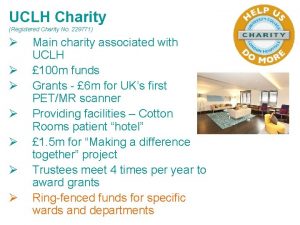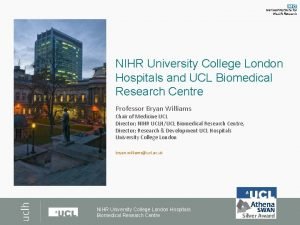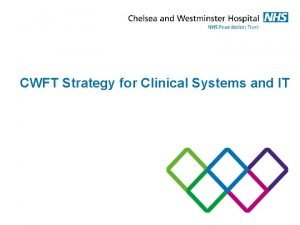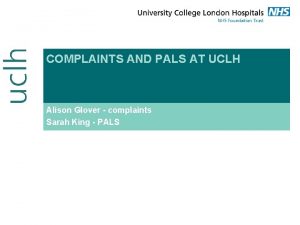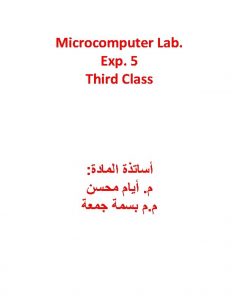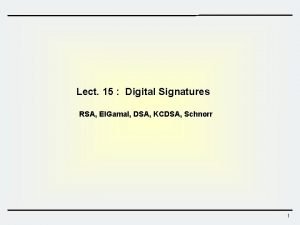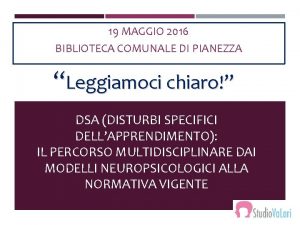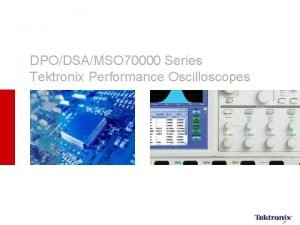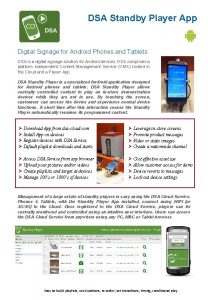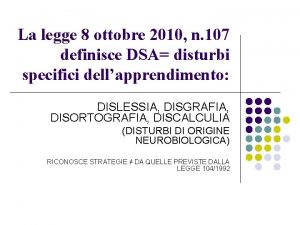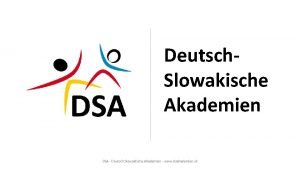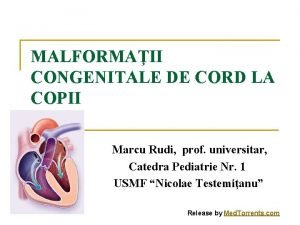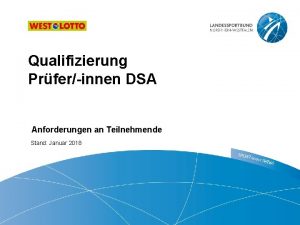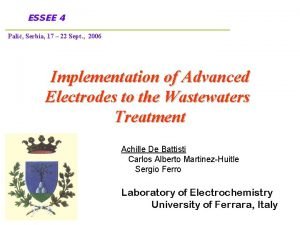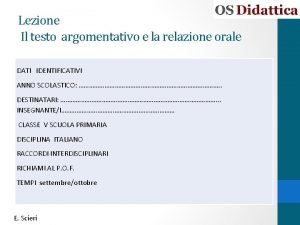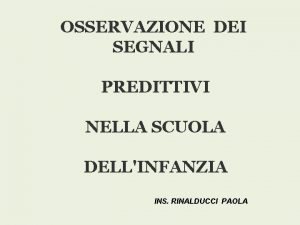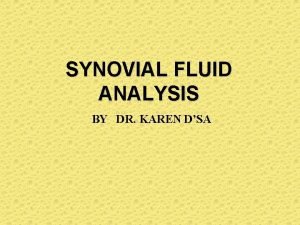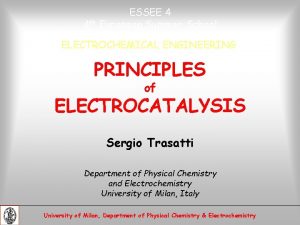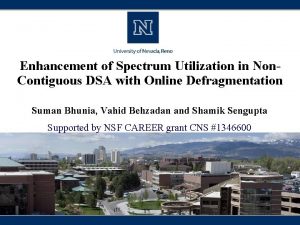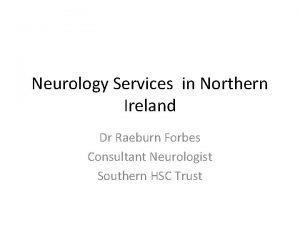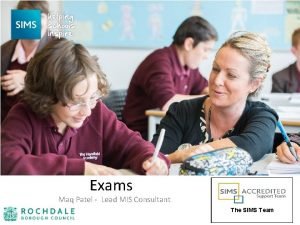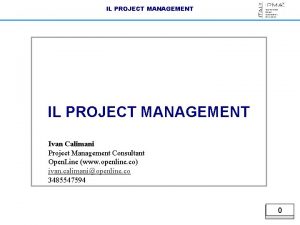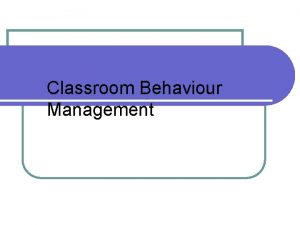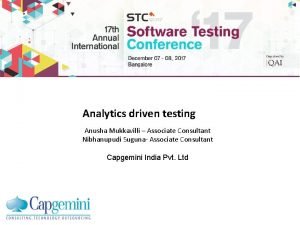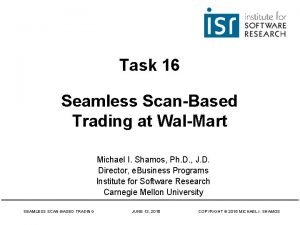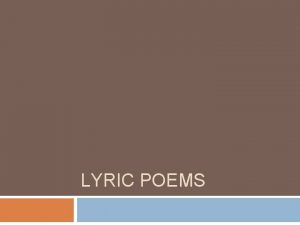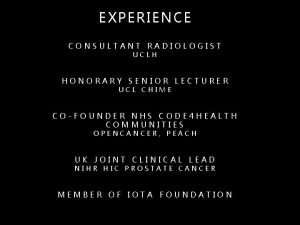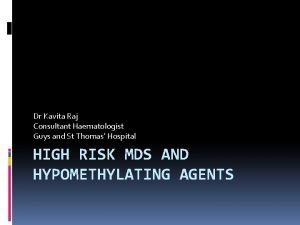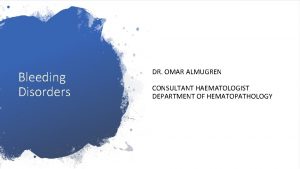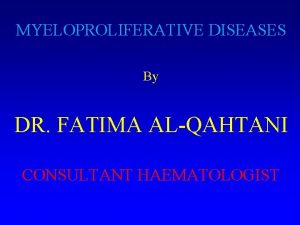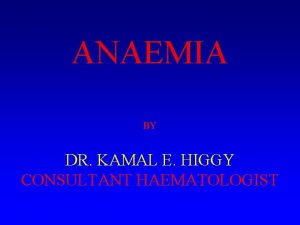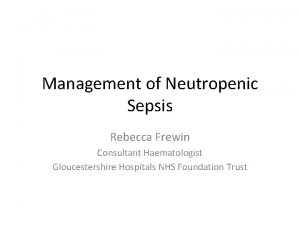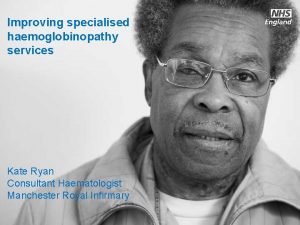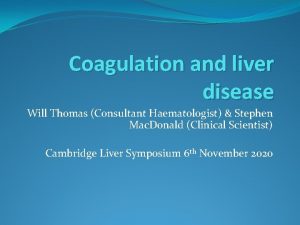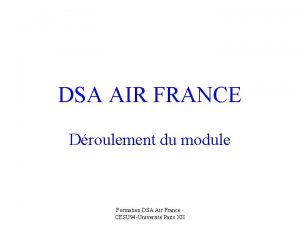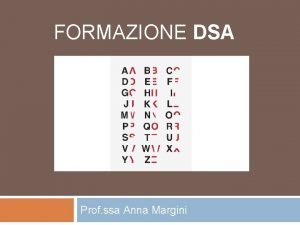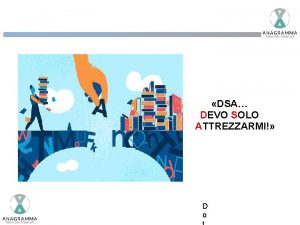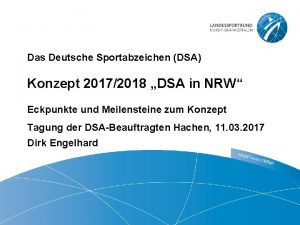POEMS Syndrome Dr Shirley DSa Consultant Haematologist UCLH














































- Slides: 46

POEMS Syndrome Dr Shirley D’Sa Consultant Haematologist UCLH Joint POEMS & Paraproteinaemic Neuropathies Clinic

Context o POEMS is a rare ‘sister’ presentation of myeloma o Subtle monoclonal proliferation and multi-system cytokine driven end organ damage o However there are very clear but poorly understood differences in pathogenesis between the two diseases o There is also an overlap between POEMS and Castlemans Disease o New therapeutics for POEMS trickle down from large multicentre randomised controlled trials in multiple myeloma with the hope of similar efficacy

Disease Overview

Epidemiology Male (60% to 70%) > Female ? High incidence in Japanese & Asian males Frequency in Japan: 0. 3 per 100, 000 Onset age: Mean 51 years Younger than myeloma

Clinical features o Comprises a selection of a range of distinctive features o Patients present within different clinical services: o Neurology- demyelinating neuropathy o Haematology- paraprotein, polycythaemia, thrombocytosis o Orthopaedic- bone lesions o Dermatology- skin lesions o Fatigue o Weight loss o Often under-recognised

Major and minor criteria

Possible pitfalls o (1) Not all of the features within the acronym are required to make the diagnosis o (2) There are other important features not included in the POEMS acronym, including o papilloedema, extravascular volume overload, sclerotic bone lesions, thrombocytosis/erythrocytosis (P. E. S. T. ) o elevated VEGF levels o a predisposition toward thrombosis o abnormal pulmonary function tests o (3) The Castleman disease variant of POEMS syndrome may be occur without a clonal plasma cell disorder. o An early diagnosis limits morbidity (Median time from onset of symptoms to diagnosis is 13 -18 months) Keddie S, D’Sa S, Foldes D, et al POEMS neuropathy: optimising diagnosis and management Practical Neurology Published Online First: 06 March 2018. doi: 10. 1136/practneurol-2017 -001792

Peripheral neuropathy: A *mandatory* criterion o The polyneuropathy associated with POEMS syndrome is bilateral and symmetrical. o It involves both motor and sensory nerves, begins distally, and has a progressive proximal spread. o Cranial and autonomic nerves are not involved. o Often mistaken for CIDP but there are clinical and neurophysiolgical differences o Failure to respond to treatments such as IVIG should prompt a second look o *Castleman Disease variant of POEMS may not include neuropathy or a plasma cell dyscrasia but has other features of POEMS

Neurophysiological features

Distinguishing features o Demyelinating neuropathy o CIDP may be suspected o Relatively rapid tempo o Pain is prominent o Characteristic distal involvement/weakness o Hands and feet o λ – restricted monoclonal plasma cell disorder o ‘Odd’ bone lesions on imaging o Importantly, a failure to respond to treatments such as IVIG, should prompt a second look o Patients have often diagnosed themselves!

Bone lesions May be osteolytic or sclerotic FDG-PET Useful for the evaluation of suspected POEMS syndrome Helpful in follow-up of patients although avidity may remain for >2 years Lytic lesions may have sclerotic rim and are more likely to show FDG avidity Soap bubble lesions Pan et al, Characterizing POEMS Syndrome with 18 F-FDG PET/CT. J Nucl Med. 2015

Haematological alterations Thrombocytosis and erythrocytosis are common BM biopsy: frequent megakaryocyte hyperplasia (54%) and clustering (93%) Often diagnosed as an MPN but JAK 2 V 617 F etc. uniformly absent 1/3 do not have clonal plasma cells in their iliac crest biopsy 2/3 have clonal cells >90% are ƛ-restricted Median percentage is <5%

Fluid overload • Very common >80% • Often severe • Types Anasarca/ peripheral oedema Pleural effusions Pericardial effusions Ascites- exudative characteristics • Associated with Increased morbidity Shorter survival

Pulmonary features o Pulmonary hypertension 27 -48% o Restrictive lung disease o Impaired neuromuscular function o Impaired diffusion capacity of carbon monoxide (DLCO) o Pulmonary emboli o Can be associated with significant right heart failure o Pulmonary function improves with effective therapy and appropriate cardiorespiratory medication

Thrombosis o Increased risk of lower limb arterial and venous thrombosis o Nearly 1 in 5 have such an event o 10% have a cerebrovascular accident (embolic, vessel dissection, stenosis) o Risk factors for CVA include thrombocytosis and BM plasmacytosis o The pathophysiological mechanism of vascular events remains unclear. o Possible causal relationship between vascular events and raised IL-6 that induces hyperfibrinogenemia. 1 o IL-1β, TNF-α, and histological abnormalities of intracranial vessels (scleroderma-like skin changes and non-inflammatory vasculopathy) could be triggers for thrombosis. 2, 3 1. 2. 3. Kang et al, Arch Neurol. 2003; 60(5): 745– 749 Lee et al, Clin Rheumatol. 2007; 26(11): 1989– 1992 Lesprti et al, Medicine. 1996; 75(4): 226– 232

Endocrinopathy • Poorly understood but important feature • Majority have evidence of multiple endocrinopathies in gonadal/ thyroid/ glucose/ adrenal axes • Hypogonadism, adrenal insufficiency, hyperprolactinoma, hypoparathyroidism, gynaecomastia • Hypogonadism is most frequent with 70% males having low testosterone, erectile dysfunction

Endocrinopathy @UCLH 75 patients with POEMS had regular endocrine screening including testing for diabetes, pituitary and thyroid dysfunction and assessment of bone metabolism Serial endocrine data were available for 59 patients between 1999 and 2018. 34 (63%) patients presented with an endocrinopathy at diagnosis and 54 (92%) had at least one endocrine abnormality at follow-up. Median follow-up was 4. 4 [1. 5 -7. 9] years. Most common endocrine abnormality was hypogonadism in 68%, hyperprolactinaemia (56%), hypothyroidism (54%), abnormal glucose metabolism (24%), adrenal insufficiency (17%) and high IGF-1 levels (15%). Resolution of endocrine abnormalities following treatment was observed: 14% in hypogonadism, 42% in hyperprolactinaemia, 34% in hypothyroidism and 38% in high IGF-1 levels. Patients with POEMS should be systematically assessed and managed by an endocrinologist

Ocular involvement Papilloedema, usually bilateral (50% to 84%) Symptoms include Blurred vision Diplopia Ocular pain Raised intracranial pressure* and elevated CSF protein levels are independently associated with papilloedema. Along with reduced DLCO is an adverse prognostic factor Can resolve with successful treatment *Some patients benefit from Acetazolamide Cui et al, J Neurol. 2014

Skin changes Hypertrichosis: Associated with endocrine disorders Hyperpigmentation: Most common skin feature (47%) Acrocyanosis & Plethora Clubbed fingers: Associated with more extensive disease Leuconychia Sclerodermatous changes

Glomeruloid haemangiomata Benign vascular neoplasia with a very characteristic appearance at histopathology in which coiled capillaries occupy a large dilated vascular space in the dermis, lined externally by a single layer of endothelial cells, resembling a renal glomerulus

Renal involvement o Serum creatinine levels are normal in most cases, but serum cystatin C, which is a surrogate marker for renal function, is high in 71% of patients. o Mayo Clinic experience o At presentation, fewer than 10% have proteinuria exceeding 0. 5 g/24 h, and only 6% have a serum creatinine >1. 5 mg/d. L. o Renal disease is more likely to occur in patients who have co-existing Castleman Disease. o In series from China, 37% of patients had a creatinine clearance (Cr. Cl) of <60 m. L/min/m 2, and 9% had a Cr. Cl of <30 m. L/min and 15% had microhematuria. o Renal histology is diverse with membranoproliferative features and evidence of endothelial injury being most common

Organomegaly § Liver (50% to 80%) § Spleen (40%): Less common with bone lesions § Lymph nodes (65%): Frequently associated with Castleman disease

POEMS and Castleman Disease • Majority are hyaline vascular type (84%) • Neuropathy of CD is more subtle than POEMS, often more sensory, but some patients are badly affected with demyelinating and axonal degeneration, normal myelin spacing but abnormal capillary proliferation • Should therapy be different? • ‘Progressive motor polyneuropathy suggesting coexistent POEMS does not respond well to IL-6–targeted therapy, and these patients require ASCT as part of their treatment plan’. Van Rhee & Fajgenbaum 2015

Pathophysiology

Pathogenesis of POEMS is not entirely known. o Elevated levels of proangiogenic and proinflammatory cytokines like VEGF, IL-6, TNF-α are believed to be instrumental. o VEGF is considered the driving cytokine in the regulation of endothelial cell proliferation, migration, and permeability and it is responsible for features as extra-vascular volume overload and papilloedema. o It was also suggested that increased VEGF levels induce higher endoneurial pressure because of oedema and increased microvascular permeability, possibly explaining the nerve damage. 1, 2 o Results of studies using anti-VEGF monoclonal antibody (bevacizumab) treatment are variable 1. Watanabe et al, Muscle Nerve. 1998; 21(11): 1390– 1397 2. Straume et al Blood. 2006; 107(12): 4972– 4974

VEGF (NR 5 -771 pg/ml) o Plasma and serum VEGF are markedly elevated in POEMS o Levels are independent of M-protein size o VEGF is found in plasma cells and platelets o Serum VEGF is characteristically 10 -fold higher than plasma VEGF (due to release of VEGF from platelets) o Level usually mirrors active disease o However, VEGF assays are not standardised between laboratories, and different cut -off values exist regarding the normal reference range. o Work needs to be undertaken to decide whether plasma or serum levels of VEGF are more accurate and useful o And how the levels correlate with treatment response

Therapy

Treatment Overview BM Biopsy clear Clonal cells on BM biopsy Clinical and formal assessment of cardiorespiratory function > 2 Bone lesions Fit for Auto Stem Cell Transplant? Can be encompassed within single radiation field? Yes No No ≤ 2 Bone lesions Yes Collect stem cells SYSTEMIC THERAPY RADIOTHERAPY Perform MEL 200 -ASCT Alkylator/Steroid Lenalidomide/ Steroid 40 -50 Gy (20 -25 fractions) Improved PS

Isolated disease: Radiation Involved lesion- radiotherapy is the treatment of choice Improves symptoms over 3 -36 months Can be curative (akin to solitary plasmacytoma) Mayo experience: 4 year OS of 97% 10 year OS 70% 4 year PFS of 52% 6 year PFS 62% So-called failures may be due to patient/physician anxiety due to slow response In case of solitary large lesion with minimal presence of disease on BM biopsy, could give radiotherapy and monitor over following 12 months (? add systemic treatment)

Systemic treatment: data • Melphalan and Dexamethasone (n=31) x 12 cycles • 81% had haematological response • 100% had VEGF response • Follow up short (21 months) • Len + Dex: Milan experience • N= 18: 13 pre-treated; 5 newly diagnosed but ineligible for ASCT • 83% completed 6 cycles • No one discontinued treatment due to toxcity • Dose reduction of Len in 6 patients (haem tox) • Dex reduced in all and subsequently suspended in 30% • After 6 m 83% improved clinically or neurologically or both • Len + Dex: Pooled analysis (n-51) • Median age of patients was 54. 5 years (range: 32 – 79 years). • Lenalidomide was given first-line in 28. 6% and second line in 47. 6% • • Haematological responses (>50% reduction in M-protein): >90. 5% 80% showed a ‘relevant clinical response’, ≥ 3 -point in CRES • 10 patients improved by ≥ 1 point in the ONLS • VEGF reduction was reported in all cases. • 2 wheelchair-bound able to walk • Neuropathy improved in 92. 0% of cases and stabilized in 8%. • Clinical improvment correlated with fall in VEGF • The progression-free survival (PFS) estimate at 12 months was 93. 9%. • After 33 months, 12/18 showed persistent remission/ stable improvement, 6 stopped due to stable disease (1 has relapsed) 1. 2. 3. Li et al, 2011 Zagouri at el, Leukemia & Lymphoma, September 2014; 55(9): 2018– 2023 Nozza et al, BJH 2017; 55(9): 2018– 2023

Autologous stem cell transplantation o Rationale: delivery of high dose melphalan to eliminate or profoundly suppress the monoclonal population o Case series suggest that 100% of cases achieve some neurological improvement o Responses are durable but relapses do occur o Should be offered to all patients who are fit enough o Prior induction with Lenalidomide-based therapy can improve cardiorespiratory function and induce fitness for ASCT o Consider pre-emptive stem cell harvest in potentially eligible patients who are due to receive pelvic radiotherapy (shelf life ~ 7 years)

EBMT data o 127 patients underwent ASCT between 1997 -2010 o Median age of 50 years (range 26 -69 years). o Median time from diagnosis to ASCT was 7. 5 months with 32% of patients receiving an autologous stem cell transplantation more than 12 months from diagnosis. o Engraftment was seen in 97% patients and engraftment syndrome was documented in 23% o Hematologic response was characterized as o CR in 48. 5%, PR in 20. 8%, < PR in 30. 7%. o With a median follow up of 48 months (95%CI: o 38. 3, 58. 6), 90% of patients are alive and 16. 5% of patients have progressed. o The 1 -year non-relapse mortality was 3. 3%. o The 5 -year probabilities of PFS of 74% and OS of 89%. (Cook et al, 2017)

ASCT @UCLH • 42 patients over 18 years: 26 male • 23 upfront; 18 after induction • Melphalan conditioning (200 mg in 40; 140 mg in 2) • Priming included cyclo-G, G-only • 3 patients had engraftment syndrome (none since Lenalidomide ‘induction’) • Significant neurological improvement in 40 patients • ONLS 6 pre and 2 post transplant • No patient who achieved a haem CR has relapsed • Those with < haem CR had a 31. 6% relapse rate • VEGF (medians): Pre 4986 pg/m. L to 489. 5 at 6 months and 330 at 1 year • Failure to attain a VEGF response was not a significant predictor of future relpase. • 6 patients have relapsed (median time to relapse 40. 5 months) • OS 92. 9% • PFS 80. 1% (median follow up 62. 6 m, range 4 -226 m) • 7 % bed bound pre ASCT, none after • Earliest clinical improvement at 2 months post transplant • NCS demonstrated improvement even 3 years after

Other options o Thalidomide: neurotoxic risks outweigh benefits o Bortezomib: similar concerns o Prior report included patients with multiple prior treatments who were already improving o Chinese experience (n=20): Cyclo/Bortezomib/Dex o Haem response 76% including one-third CR o VEGF response 88% o Neuro reponse 95% (reduction of ONLS by 1 or more o No neurological deterioration

Trials: Mayo Clinic ▪ IRD in POEMS (NCT 02921893) : target 34 patients until 2021 ▪ Experimental Group I: IRD x 3 then ASCT ▪ Experimental Group II: IRD for up to 13 courses in the absence of disease progression or unacceptable toxicity o Primary Outcome Measures: Rate of normalization of VEGF [Time Frame: Up to 3 months] o Secondary Outcome Measures: Hematologic response rate [Time Frame: Up to 3 months]; Hematologic response rate [Time Frame: Up to 12 months]; Hematologic response rate after 13 cycles of therapy (or 12 months) o Incidence of adverse events [Time Frame: Up to 3 years] o Survival time [Time Frame: Time from registration to death due to any cause, assessed up to 3 years] o Other measures include Neuropathy scales, PET responses, cardiac echo, DLCO…

Clinical outlook

Course and prognosis o Chronic course spanning months to years as long as treated. o ASCT and novel agents may prolong survival o 10 year overall survival o Before 2003: 55% o After 2003: 79% o Lower OS associations? Extravascular volume overload Renal dysfunction Pulmonary hypertension Finger clubbing Impaired DLCO Pulmonary hypertension Age >50 years Pulmonary hypertension Pleural effusion e. GFR<30 ml/min/1. 73 m 2 Level of pre-treatment VEGF Number of POEMS features Other factors influencing survival: Candidates for radiotherapy (better), co-existing Castlemans (worse); thrombocytosis (greater risk of stroke) *Wang et al Leukaemia, 2017

Response assessment

Assessment of response Am J Hematol. 2017; 92: 814– 829

Various attempts to develop response criteria o Li et al: 80% haematological response rate, with almost 40% of participants achieving a complete response. 1 o Misawa: VEGF levels at 24 weeks compared to baseline, demonstrating significantly reduced VEGF levels in thalidomide treated patients compared to placebo. 2 o Nozza et al designed a ‘Clinical Response Evaluation Scale’ (CRES). 3 o CRES grades 10 POEMS features and attributes a score of 0 -2 to each (total 0 -20) dependent on severity. o They illustrated improvements in CRES score and neuropathy features (using the Overall Neuropathy Limitations Score, ONLS) in their cohort of 18 patients treated with Lenalidomide. 1. Blood 117, 6445– 6450 (2011). 2. Lancet Neurol. 15, 1129– 1137 (2016). 3. Br. J. Haematol. 748– 755 (2017). doi: 10. 1111/bjh. 14966

More questions than answers o How does a drop in VEGF to the normal range compare to a complete haematological response? o What combination of assessment criteria most accurately measures clinical outcome and likelihood of long term remission? o o How important is haematological response in POEMS syndrome? o Additionally, serum monoclonal protein levels may not be as reliable in response measurement as they are in myeloma. o The M-protein is often small and measurable only at the lower limit of detection POEMS manifests as a more subtle monoclonal disorder, in which immune mediated cytokine activation and proliferation appear to cause end organ damage rather than light chain deposition seen in myeloma.

Neuropathy • Neuropathy is the most prominent feature of POEMS syndrome resulting in severe morbidity and disability. • Several neuropathy severity scales exist; the Overall Disability Sum Score (ODSS), the Rotterdam Inflammatory Neuropathy Cause and Treatment scale (INCAT), the Overall Neuropathy Limitation Scale and the Rasch-built Overall Disability Scale (R-ODS) • Designed using patients with a range of inflammatory neuropathies, most commonly Guillain-Barré and CIDP. • POEMS neuropathy fits in the inflammatory group, but the neuropathy is not the same. • • POEMS neuropathy takes a long time to change • It therefore cannot be used as a reliable or accurate predictor of response in the months immediately following treatment. UCLH: median ONLS was 6, then 4 at three years following treatment and 3 on most recent follow up demonstrating ongoing improvement.

Organ Responses • Degree of organ involvement also appears to influence outcome in POEMS syndrome. • Age over 50, pulmonary hypertension, pleural effusion and glomerular filtration rate were determined as baseline characteristics which could estimate the 5 and 10 year overall survival, identified via a multivariate Cox hazards model of 362 POEMS cases in China 1. • Dispenzieri et al identified age, albumin level and achievement of complete haematological remission as the only factors associated with disease progression 2. • Such inconsistencies in different cohorts make organ response criteria difficult to define. 1. Leukemia 31, 100– 106 (2017). 2. Leukemia 30, 1079– 1085 (2016)

Planned project • • More work needs to be undertaken with larger patient cohorts from multiinternational centres to identify reliable poor prognosticating factors, and whether improvements in such characteristics leads to improved outcomes and higher rates of remission. In order to design clinical trials in POEMS in which therapies can be assessed and compared in systematic meta-analysis, more robust, accurate and internationally recognised response criteria which accurately reflect disease severity and change are urgently needed. Clinical, radiological, haematological and biochemical indices should be incorporated. A collaborative network under the auspices of EBMT is planned to combine patient numbers for statistically powered analysis. 45

POETRY: The Final Verse Complex, multifaceted disease Treatable Early diagnosis limits morbidity and mortality NEUROLOGISTS: Consider if ‘resistant’ CIDP HAEMATOLOGISTS: Consider in cases of unexplained myeloproliferation, Castleman disease, lambda light chain RADIOLOGISTS: Raise the possibility in case of unusual bone lesions: mixed lytic/sclerotic DERMATOLOGISTS: Vasculopathy? Think POEMS… ALL: believe the patient if they think it’s POEMS!

Neuro-Haematology Team at UCLH
 Uclh charity
Uclh charity Nihr brc
Nihr brc Medirota uclh
Medirota uclh Pals uclh
Pals uclh Shirley toulson images
Shirley toulson images Syndrome de poems
Syndrome de poems Equità
Equità Dsa code
Dsa code Digital signature
Digital signature Dsa pr 17-03
Dsa pr 17-03 Schema goldoni
Schema goldoni Biblioteca pianezza
Biblioteca pianezza Dsa70604c
Dsa70604c Dsa android
Dsa android Legge 107 dsa
Legge 107 dsa Aufmerksamkeit dsa
Aufmerksamkeit dsa Transpozitie de vase mari corectata anatomic
Transpozitie de vase mari corectata anatomic Dsa large letter
Dsa large letter Dsa gold anforderungen
Dsa gold anforderungen Dsa personal statement example
Dsa personal statement example Dsa major
Dsa major Dsa code
Dsa code Dsa
Dsa Differenza tra dsa e bes
Differenza tra dsa e bes Piano cartesiano per dsa
Piano cartesiano per dsa Essee4
Essee4 Testo argomentativo sulla televisione
Testo argomentativo sulla televisione Segnali predittivi
Segnali predittivi Dsa
Dsa Rsa signature
Rsa signature Rhomboid shaped crystals
Rhomboid shaped crystals Metodo di studio e dsa riassunto
Metodo di studio e dsa riassunto Dsa in network security
Dsa in network security Dsa anodes
Dsa anodes Dsa
Dsa Neurology consultants northern ireland
Neurology consultants northern ireland Mis consultant
Mis consultant Legal nurse consultant websites
Legal nurse consultant websites Principal consultant significato
Principal consultant significato Assertivel
Assertivel Fdot current advertisements
Fdot current advertisements Module engineering consultant
Module engineering consultant Open source consultant
Open source consultant Associate consultant in capgemini
Associate consultant in capgemini Green world group
Green world group Court security consultant
Court security consultant Scan based trading data
Scan based trading data
